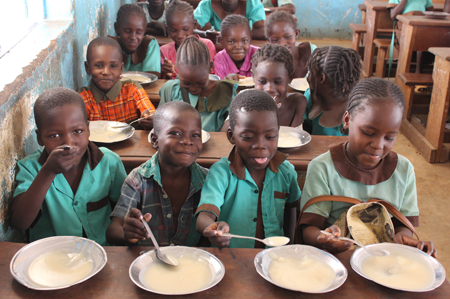
Assisting 80 million people in around 80 countries each year, the World Food Programme (WFP) is the leading humanitarian organization saving lives and changing lives, delivering food assistance in emergencies and working with communities to improve nutrition and build resilience.
As the international community has committed to end hunger, achieve food security and improved nutrition by 2030, one in nine people worldwide still do not have enough to eat. Food and food-related assistance lie at the heart of the struggle to break the cycle of hunger and poverty.
On any given day, WFP has 5,000 trucks, 20 ships and 92 planes on the move, delivering food and other assistance to those in most need. Every year, we distribute approximately 12.6 billion rations at an estimated average cost per ration of US$ 0.31. These numbers lie at the roots of WFP’s unparalleled reputation as an emergency responder, one that gets the job done quickly at scale in the most difficult environments.
WFP’s efforts focus on emergency assistance, relief and rehabilitation, development aid and special operations. Two-thirds of our work is in conflict-affected countries where people are three times more likely to be undernourished than those living in countries without conflict.

In emergencies, WFP is often first on the scene, providing food assistance to the victims of war, civil conflict, drought, floods, earthquakes, hurricanes, crop failures and natural disasters. When the emergency subsides, WFP helps communities rebuild shattered lives and livelihoods. We also work to strengthen the resilience of people and communities affected by protracted crises by applying a development lens in our humanitarian response.
WFP development projects focus on nutrition, especially for mothers and children, addressing malnutrition from the earliest stages through programmes targeting the first 1,000 days from conception to a child’s second birthday, and later through school meals.
WFP is the largest humanitarian organisation implementing school feeding programmes worldwide and has been doing so for over 50 years. Each year, WFP provides school meals to between 20 and 25 million children across 63 countries, often in the hardest-to-reach areas.
WFP purchases more than 2 million metric tons of food every year. At least three quarters of it comes from developing countries. By buying food as close as possible to where it is needed, we can save time and money on transport costs, and help sustain local economies. Increasingly, WFP meets people’s food needs through cash-based transfers that allow the people we serve to choose and shop for their own food locally.
WFP also provides services to the entire humanitarian community, including passenger air transportation through the UN Humanitarian Air Service, which flies to more than 250 locations worldwide.
Funded entirely by voluntary donations, in 2016 WFP raised US$5.9 billion. WFP has more than 14,000 staff worldwide of whom over 90 percent are based in the countries where the agency provides assistance.
WFP is governed by a 36-member Executive Board. It works closely with its two Rome-based sister organizations, the Food and Agriculture Organization of the United Nations and the International Fund for Agricultural Development. WFP partners with more than 1,000 national and international NGOs to provide food assistance and tackle the underlying causes of hunger.
Full content souce : http://www1.wfp.org/overview
Image source : https://ETHNews.com
Image source : https://astrotvboxes.ca/world-food-programme/
Please give us your opinion about this matter write in comment and follow me.
Hi! I am a robot. I just upvoted you! I found similar content that readers might be interested in:
http://www1.wfp.org/overview
yes but i give credit for this written owner
thanks for the interesting story😃
thank you for spend your time.
Sir thanku soo much for upvoting and helping me
wellcome bro. upvote me and follow me
My pleasure sir
uvot back
My pleasure sir
Here u go